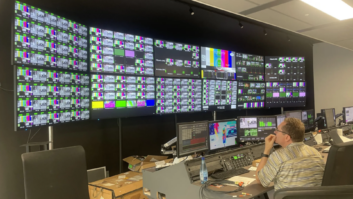In the final instalment of our series looking at some of the predicted trends within the media and entertainment industry in 2024, we look at the industry itself.
From the revolution of the TV experience, brought about by interactive shopping and monetisation, to a change the definition of who is a broadcaster, the industry is expected to see a number of changes in the next 12 months.
Adam Leah, creative director, nxtedition
I see 2024 as the year where we see centralisation, consolidation and localisation come to the fore. With the big tech companies encroaching more into the media and entertainment space the paradigm is beginning to shift.
The traditional incumbent broadcasters will need to work with the big tech companies while competing with them at the same time. That is going to need far more modern, digital native toolsets and agile workflows. Content needs to be on the big tech platforms as well as the broadcasters’ own, it needs to be connected to where the eyeballs are.
Basically, no one can be YouTube, but you can be on YouTube. At the same time, big tech cannot reach a local community in the way a broadcaster can, so play to your strengths.
Meghna Krishna, chief revenue officer, Magnifi
In 2024, we anticipate several key trends that will shape the media and entertainment landscape. The primary focus will be on collaborations between broadcast and media entities, resulting in top-tier content and increased audience reach through combined resources and expertise. In addition, the integration of ticketing assistance is primed to revolutionise how audiences engage, seamlessly fusing together to streamline attending live events and offering a comprehensive and immersive entertainment experience.
Social media is predicted to play an increasingly important role, as platforms develop to offer deeper levels of interaction. Technology has empowered creators to establish stronger connections with their audience, allowing real-time interactions and feedback loops. AI and Generative AI are set to contemporise collaboration in the media and entertainment industry in 2024. Automation will make content creation more efficient and time-saving, resulting in higher viewer engagement and satisfaction.
In the past decade, we’ve learned that providing viewers with instant and relevant real-time updates is crucial for an engaging experience in news and live events. Moreover, integrating chatbots and virtual assistants shall further enhance user experience, offering instant support, personalised recommendations, and streamlined user interactions.
In the future, we imagine a greater emphasis on crowd monitoring and support during events, incorporating cutting-edge technologies to guarantee the well-being and contentment of participants. The entertainment industry is moving towards a more dynamic, interactive, and audience-centric future.
Clive Kingston, UK director of production and operations, Memnon
I think that there will be a growing need for the industry to address the widening skills gap, particularly in the engineering and operator segments of archive-base fields. While a plethora of digital-focused courses are available, there is a growing urgency both in archiving and across the broadcast sector to ensure the practical skills that have been the bedrock of the industry aren’t lost. Bridging this knowledge gap requires re-training and mentoring to harness the diminishing existing expertise, and I hope to see more initiatives in this regard in the coming year.
Additionally, sustainability will continue to be of paramount concern for the archiving industry. Clients will prioritise eco-friendly practices, aiming to reduce the environmental impact of legacy heritage. This includes evaluating the carbon footprint of archives and considering the costs and benefits of transitioning to cloud-based storage solutions.
As we navigate the ever-evolving landscape of media and entertainment, 2024 promises to bring exciting developments and solutions to these critical industry challenges.
Johan Bolin, chief business officer, media and business, Agile Content
Broadcasters and TV companies will, because they must, start to explore new technology stacks and new models where the roles of companies involved will look a little different – what vendors are providing and what the broadcasters and TV companies do themselves will change. Again, the key will be seeking inspiration from the internet industry and taking stock on how those companies operate and succeed. It will also require a competence shift in those companies and new models more inspired by software with open APIs, open source and continuous development in frequent smaller steps rather than big slow standardisation-driven leaps.
I expect some bold changes in direction among a few pioneering broadcasters and TV companies who will “show the way” by daring to embrace new technology and models that don’t originate from the broadcast industry. The technology shift will trigger increased focus on operational, organisational and cultural aspects. We will see how such a shift enables or facilitates increased use of tools, such as AI, within production and curation. We’ll also see how it enables experimentation with formats, such as the fusion of TV with gaming/esports concepts, particularly in the sports and news domain where the goal is to create formats and concepts that attract a young generation of “internet natives”.
Jon Fry, CEO, CVP
I am expecting to see more new product launches in 2024, and whilst most equipment has been readily available in the last six months, we can predict that there will likely be a shortage in 2024. Therefore, the need for stock to be available and on the shelf will become more important, so that we can meet the ever-increasing demand for immediate technology and talent.
Mike Ward, head of marketing, Singular.live
We will see a lot of consolidation across our industry from both the production and distribution sides. Many traditional players will either be consumed or overwhelmed, such is the pace of change. The emergence of massive technology companies will also continue to further impact the broadcast and media industry as they dominate through sheer unassailable scale. At the same time, traditional broadcasters and media companies, especially those who are largely backed by Private Equity, will make more efforts to diversify. You can see that happening already in the UK with the likes of Sky migrating to non-traditional products and solutions, such as TVs, insurance and home security, as they seek to grow their profitability and value to shareholders.
Carol Bettencourt, vice president of marketing, Chyron
An ongoing trend that will continue to gain prominence in 2024 is the shifting definition of who is a broadcaster and what it means to be a broadcaster. We’re already seeing new pundits and newscasters on the air. It’s no longer just major networks who get to analyze the news; anyone who can set up a ring light and a camera can make the jump. Smaller productions can add further storytelling dimensions to what they’re doing now by taking advantage of cloud production tools, AI, data, a virtual set, and more immersive visuals.
Andy Shenkler, CEO and co-founder TMT Insights
We have already seen a series of layoffs take place throughout the industry, including the technology giants, which are closely tied to M&E at this time. We expect that the first half of 2024 will see further reductions across the spectrum as companies prepare for potentially more difficult times. Investments in technology and content won’t stop, but merely slow down. Many companies will shift greater investment from outsourced vendors to insourcing all but the most commoditised sets of services to ensure service continuity when faced with the possibility of a smaller footprint of post-production vendors who run at low margins, which may not be able to weather a rough economic run.
Dror Mangel, vice president of TV products and solutions, Viaccess-Orca
In recent years, there’s been a notable shift in how the television — traditionally a medium for passive entertainment — is perceived and utilised. As screen sizes grow, and as technology becomes more integrated, the TV is poised to become the epicentre of the modern household and is set to go beyond entertainment. The vision is to seamlessly connect the big screen with other devices in the home, as well as with mobile data, to offer a unified and immersive user experience.
We’ll also see an increase in interactive shopping and monetisation. Several video service providers are looking to transform passive advertising into interactive experiences. The future might see viewers directly purchasing products showcased in commercials or within content, from their TV screens. As TVs evolve into e-commerce platforms, there’s potential for TV service providers to step in as payment processors. Essentially, they could become the “wallet” for viewers, streamlining transactions made through the TV. Advanced LLM algorithms, like ChatGPT, will be pivotal in this transformation. They can offer personalized content suggestions, assist with shopping queries, enable productisation of content recommendations and enhance interactive advertising. Their potential in revolutionising the TV experience cannot be underestimated.
Terri Davies, president, TPN
We are all adapting to continuous change in the industry, whether it’s generative AI and machine learning or new business models shaping our industry ecosystem. But what’s certain is that improving cyber security is critical and vital to any business and this will continue in 2024. I’m seeing increased buy-in at the board level, where companies are not only understanding the importance of cybersecurity initiatives but elevating them in the boardroom agenda. Chief information security Officers (CISOs) are being added to organisations to develop and lead security strategies that understand and mitigate risk. This requires working across functions within an organisation and applying critical thinking and adaptability to what was once a fixed set of technological skills and practices. Agility is key when you consider the speed at which generative AI is growing. In essence, what were once considered ‘soft skills’ are rapidly becoming ‘hard skills.’ Being willing to adapt, learn, collaborate, and reframe the traditional are now must-haves, not nice-to-haves.
Oscar Gutierrez, VP business development, Switch Media
If we take a step back, what we’re talking about is the need to continually develop and explore ways of better monetising services. We’re all fully aware of the impact of the cost-of-living crisis and what that means when it comes to consumer spending. As well as the increase in hybrid options, we’re likely to see other alternative AVoD business models.
As an industry, we’re also likely to see some consolidation and M&A activity with the major players as, being blunt, there are simply too many services all targeting the same spend. This applies right across the television industry as consumers, even in high ARPU countries, question the value of multiple subscriptions. The difficulty for SVoD and AVoD service providers now is finding a balance between keeping charges low for the consumer in a cost-of-living-crisis and being able to create and deliver the highest-quality content. That’s why the relationship between technology and service provider is absolutely crucial in a market with so many variables.
David Dellea, director, Altman Solon
In addition to consolidation, I’d expect some level of an industry-wide reduction in the reliance on monthly subscriptions for sports content. This could take the shape of a gradual return to ad-supported models for certain content, or at least a more balanced FREEMIUM model that blends pay and free access. There is evidence that in the right circumstances, live sports can work well as ad-supported content like it did for decades. It will also be interesting to see if more providers go to a limited pay-per-view model, especially with the success DAZN and ESPN have shown attracting combat sports fans.
Venugopal Iyengar, COO, digital, Planetcast
The sports market has been evolving so rapidly in recent years and it will continue to do so in 2024. Viewer engagement and monetisation will be two of the major trends that will be a big focus for companies and sports organisations, particularly as rights valuation continue to rise. A result is that rights holders will put an even greater emphasis on viewer engagement, a key driver for generating revenue streams. Features like Interactivity around streaming content and advertising aim to increase engagement and these will be in focus.






